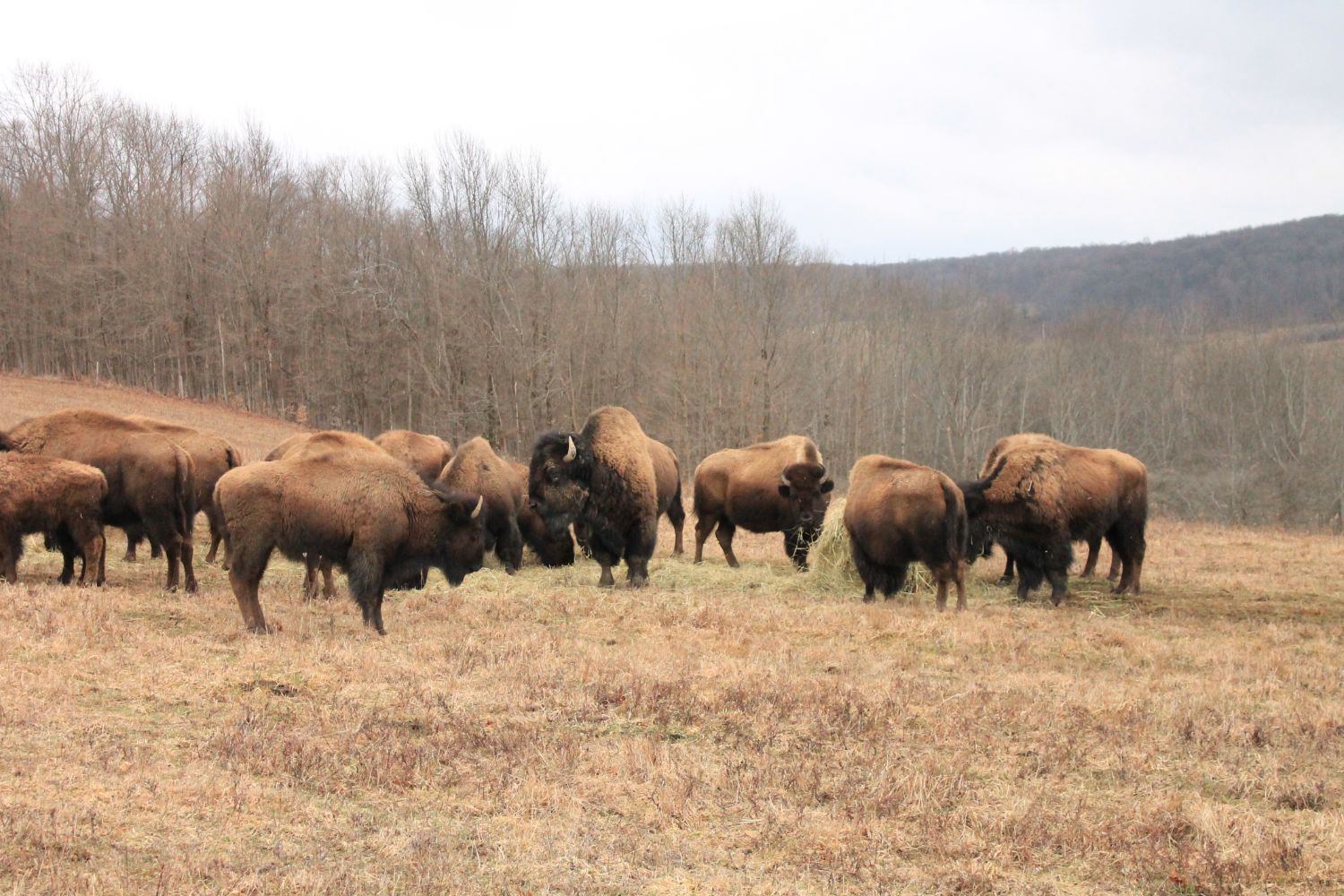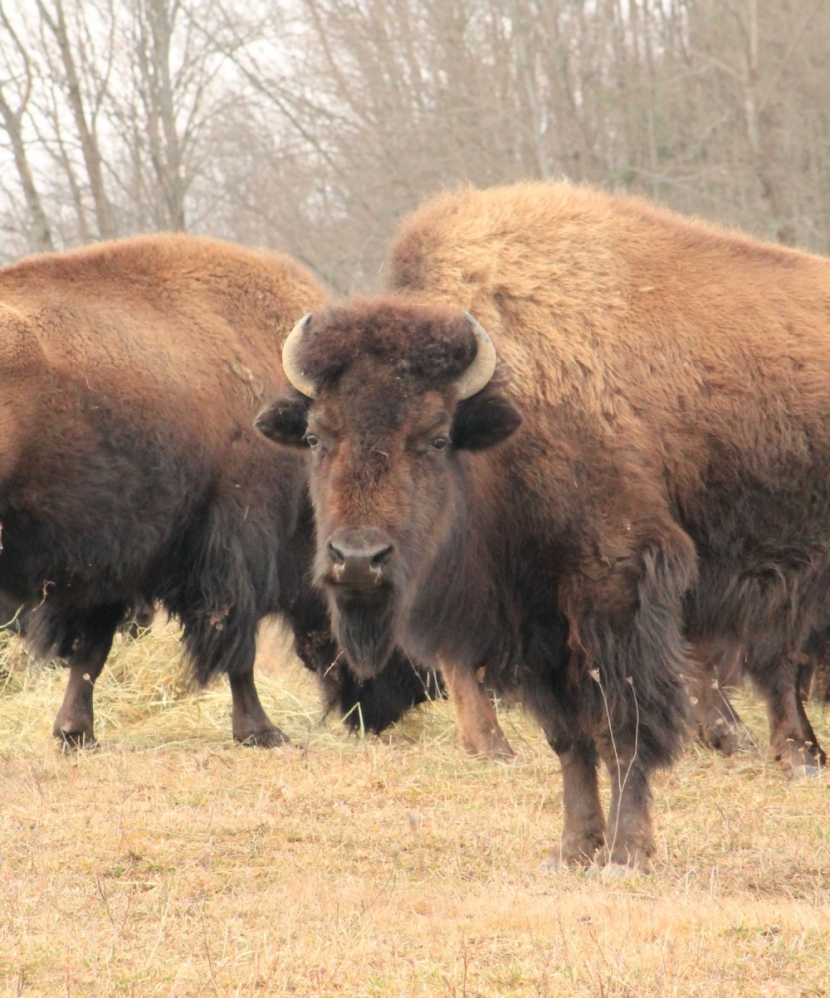Maple Ridge Bison Ranch: Where the Buffalo Roam
Jeffrey Goodyear is a fifth-generation dairy farmer who left the family farm for a job in telecommunications. Even though he was well paid and found the occupation easier than farming, he missed life on the farm.
“I grew up milking cows,” Goodyear says. “Once you work with animals, it’s in your blood. Four generations of my family farmed here. My roots run deep in this land. There’s a local cemetery up the road where my great-grandmother was buried in 1869.”
Traveling in the West and Midwest, particularly in Colorado, Goodyear saw bison run freely. He wondered if he could help reintroduce bison to Western New York.
After many years of travel—enduring separations from family—he retired from his job to purchase the family farm and one day raise bison.
“Bison are majestic animals,” he says. “They appear slow and docile but they’re the opposite. Their independent natures set them apart. Bison follow a distinct and established social order. They’re fascinating creatures, very protective of one another.”
In 2001, he purchased 10 bison from an auction in Pennsylvania, shipped them to his farm in Hinsdale, New York, and became a rancher overnight. The following year, he bought 60 more from the Black Hills of South Dakota.
Today, Goodyear’s bison graze on native grasses in the rolling hills of the Allegheny region, known as the Enchanted Mountains, just 60 miles south of Buffalo. Maple Ridge Bison Ranch boasts 325 acres; 225 of those acres are fenced with six- to eight-strand high-tensile wire and pressure-treated posts to contain the bison. Today, the herd numbers over 60, with calves being born each spring.
“We cleared the pastures with the help of family and friends, building and repairing fence on evenings, weekends and holidays,” Goodyear recalls. “Electric fences are needed because a male bull can weigh up to 2,800 pounds. Our bison roam freely and are generally non-aggressive. But sometimes, there are disputes between males for dominance.”
The Plains bison on Goodyear’s ranch are native to North America though they’ve had to adjust to the rich grasses of Western New York.
“Our bison graze on both timothy and orchard grasses along with other natural grasses,” he says. “South Dakota is dry. The grass there is sparse. It took our animals nearly five years to adapt to the grasses here.”
Goodyear, who supports the growth of natural, sustainable agriculture, keeps his bison healthy and free from parasites by feeding them apple mash from a local cider mill each fall.
“We do not use growth hormones, antibiotics or steroids,” he says. “The apple mash we feed our bison includes apple seeds. These seeds contain arsenic, which reduces the incidence of parasites. We also provide mineral selenium blocks to the animals because the soil in this region is weak in minerals. Selenium protects bone health, necessary for large animals like bison.”
When asked if there is any danger tending to such large animals, Goodyear replies, “Being respectful of these animals and knowing their behaviors is key. As I tend and feed them every day, the bison no longer look at me as a predator. They want to know how I fit into their social order. It’s important to remember though, they are still wild animals. I never turn my back on any of the animals in my herd.”
In the early years, Goodyear sold bison burgers and steaks at farmers’ markets. “It was a tough sell back then,” he says. “People weren’t aware of the flavor potential and health benefits of bison.”
When meat wasn’t selling, he began cooking at local fairs and festivals—Octoberfest in Ellicottville and the Erie County Fair—so shoppers could taste for themselves. Customers slowly came around. Goodyear got creative with his offerings; for example, Beef on Weck became Bison on Weck.
According to Goodyear, bison meat has caught on in the last 10 years with popularity projected to increase as health benefits become more widely known. He says it took 20 years to build a following.
Because bison meat is lean, it’s low in calories, fat and cholesterol yet high in protein, minerals, iron and omega-3 fatty acids. Touted as a lean meat alternative to poultry or fish, bison is also fast becoming known as a heart-healthy alternative to beef. According to Goodyear, bison tastes similar to beef yet is slightly sweet.
Since several regional restaurants have begun ordering his meats, it has been challenging to keep up with demand. All Griffon Gastropub locations from Niagara Falls to Youngstown feature Maple Ridge Bison Ranch meat. Allen Burger Venture on Allen Street in Buffalo (whose buffalo burger was named one of the best in the country), Roaming Bison Tavern on Hertel Avenue in Buffalo and Four Mile Brewery and Union Whiskey in Olean also purchase bison meat from Maple Ridge Bison Ranch.
“We keep up with demand by processing meat throughout the year. RL Falconer Inc., in Arcade, processes our bison. We sell our meat by the cut, frozen, to restaurants and to customers who purchase meat directly from the ranch,” Goodyear explains. Bison burgers sell for $9.00/lb. with tenderloin or top sirloin at $20.95/lb.
“Our bison meat is grass-fed with no gamey flavor,” he adds. “A dense, lean meat, bison cooks faster than beef. Low and slow is the best way to prepare bison.”
His advice: Sear bison meat on a charcoal grill. Cooking bison rare to medium rare with an internal temperature of 135–155 degrees is recommended: season with olive oil, salt and pepper and cook over mesquite chips. He also suggests cooking bison roast in a slow cooker at 325 degrees until it falls off the bone.
To meet demand, Goodyear has grown his herd. He’s found 60–65 bison is a sustainable herd for his ranch. “We consider droughts and what is a manageable number of animals for this area and the conditions,” he says.
Animals are kept outdoors all year long. “Bison do not like to be confined,” he explains. “They can handle the cold. When it’s 10 below, they run around, play tag.”
The bison are now a local attraction. Maple Ridge Bison Ranch is listed in a tour guide sponsored by Cattaraugus County Economic Development Corporation. “People call, stop by to see the bison. They ask me, ‘Where are the bison?’ I say, ‘They could be just about anywhere. After all, they live on 225 acres.’”
Maple Ridge Bison Ranch also harvests maple syrup each spring from mature maple trees on the ranch. “I’ve had a building under construction for a while now,” says Goodyear. “My dream is to serve pancake breakfasts with bison sausage and maple syrup. Someday …”
While Goodyear’s dream of pancake breakfasts may be a ways off, his dream of owning a bison ranch has finally been realized.
BISON TRIVIA
It’s estimated that North American bison once numbered between 30–50 million. In the 1890s, they faced near extinction as European settlers slaughtered all but fewer than a thousand bison.
Through careful breeding and nurturing, herd sizes in the U.S. and Canada now number close to 500,000. Most herds are privately owned but public herds can be found in several parks and wildlife refuge areas including Yellowstone National Park, the National Bison Refuge in Montana and Custer State Park in South Dakota.
A full-grown bison bull will stand six feet tall at his hump and can weigh in excess of a ton! Both male and female bison have horns. Herbivores, they are great swimmers, can jump over six feet from a standstill and can run 35 mph.
Prior to the mating season in August, bulls battle fiercely for the right to breed. This can lead to injury or even death for all but the largest, most dominant males. When breeding season is over, bulls return to their bachelor groups and stay apart from the rest of the herd for much of the year.








